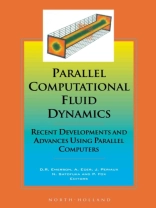Computational Fluid Dynamics (CFD) is a discipline that has always been in the vanguard of the exploitation of emerging and developing technologies. Advances in both algorithms and computers have rapidly been absorbed by the CFD community in its quest for more accurate simulations and reductions in the time to solution. Within this context, parallel computing has played an increasingly important role. Moreover, the uptake of parallel computing has brought the CFD community into ever-closer contact with hardware vendors and computer scientists. The multidisciplinary subject of parallel CFD and its rapidly evolving nature, in terms of hardware and software, requires a regular international meeting of this nature to keep abreast of the most recent developments.Parallel CFD ’97 is part of an annual conference series dedicated to the discussion of recent developments and applications of parallel computing in the field of CFD and related disciplines. This was the 9th in the series, and since the inaugural conference in 1989, many new developments and technologies have emerged. The intervening years have also proved to be extremely volatile for many hardware vendors and a number of companies appeared and then disappeared. However, the belief that parallel computing is the only way forward has remained undiminished. Moreover, the increasing reliability and acceptance of parallel computers has seen many commercial companies now offering parallel versions of their codes, many developed within the EC funded EUROPORT activity, but generally for more modest numbers of processors. It is clear that industry has not moved to large scale parallel systems but it has shown a keen interest in more modest parallel systems recognising that parallel computing will play an important role in the future. This book forms the proceedings of the CFD ’97 conference, which was organised by the the Computational Engineering Group at Daresbury Laboratory and held in Manchester, England, on May 19-21 1997. The sessions involved papers on many diverse subjects including turbulence, reactive flows, adaptive schemes, unsteady flows, unstructured mesh applications, industrial applications, developments in software tools and environments, climate modelling, parallel algorithms, evaluation of computer architectures and a special session devoted to parallel CFD at the AEREA research centres. This year’s conference, like its predecessors, saw a continued improvement in both the quantity and quality of contributed papers.Since the conference series began many significant milestones have been acheived. For example in 1994, Massively Parallel Processing (MPP) became a reality with the advent of Cray T3D. This, of course, has brought with it the new challenge of scalability for both algorithms and architectures. In the 12 months since the 1996 conference, two more major milestones were achieved: microprocessors with a peak performance of a Gflop/s became available and the world’s first Tflop/s calculation was performed. In the 1991 proceedings, the editors indicated that a Tflop/s computer was likely to be available in the latter half of this decade. On December 4th 1996, Intel achieved this breakthrough on the Linpack benchmark using 7, 264 (200MHz) Pentium Pro microprocessors as part of the ASCI Red project. With the developments in MPP, the rapid rise of SMP architectures and advances in PC technology, the future for parallel CFD looks both promising and challenging.
A. Ecer & D. Emerson
Parallel Computational Fluid Dynamics ’97 [PDF ebook]
Recent Developments and Advances Using Parallel Computers
Parallel Computational Fluid Dynamics ’97 [PDF ebook]
Recent Developments and Advances Using Parallel Computers
Cumpărați această carte electronică și primiți încă 1 GRATUIT!
Limba Engleză ● Format PDF ● Pagini 681 ● ISBN 9780080538372 ● Editor A. Ecer & D. Emerson ● Editura Elsevier Science ● Publicat 1998 ● Descărcabil 6 ori ● Valută EUR ● ID 2261900 ● Protecție împotriva copiilor Adobe DRM
Necesită un cititor de ebook capabil de DRM












